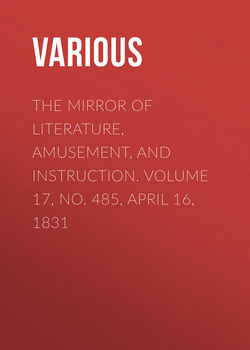Читать книгу The Mirror of Literature, Amusement, and Instruction. Volume 17, No. 485, April 16, 1831 - Various - Страница 1
MOCHA
Оглавление“Bon pour la digestion,” said the young Princess Esterhazy, when sent to bed by her governess without her dinner; we say the same of coffee; and hope the reader will think the same of Mocha, or the place whence the finest quality is exported.
Mocha, the coffee-drinker need not be told, is a place of some importance on the borders of the Red Sea, in that part of Arabia termed “Felix,” or “Happy.” “The town looks white and cheerful, the houses lofty, and have a square, solid appearance; the roadstead is almost open, being only protected by two narrow spits of sand—on one of which is a round castle, and the other an insignificant fort.”
Lord Valentia1 visited Mocha repeatedly during his examination of the shores of the Red Sea; and his description is the most full and minute:—
“Its appearance from the sea is, he says, tolerably handsome, as all the buildings are white-washed, and the minarets of the three mosques rise to a considerable height. The uniform line of the flat-roofed houses is also broken by several circular domes of kobbas, or chapels. On landing at a pier, which has been constructed for the convenience of trade, the effect is improved by the battlements of the walls, and a lofty tower on which cannon are mounted, which advances before the town, and is meant to protect the sea gate. The moment, however, that the traveller passes the gates, these pleasing ideas are put to flight by the filth that abounds in every street, and more particularly in the open spaces which are left within the walls, by the gradual decay of the deserted habitations which once filled them. The principal building in the town is the residence of the dola, which is large and lofty, having one front to the sea, and another to a square. Another side of the square, which is the only regular place in the town, is filled up by the official residence of the bas kateb, or secretary of state, and an extensive serai, built by the Turkish pacha during the time that Mocha was tributary to the Grand Seignior. These buildings externally have no pretensions to architectural elegance, yet are by no means ugly objects, from their turretted tops, and fantastic ornaments in white stucco. The windows are in general small, stuck into the wall in an irregular manner, closed with lattices, and sometimes opening into a wooden, carved-work balcony. In the upper apartments, there is generally a range of circular windows above the others, filled with thin strata of a transparent stone, which is found in veins in a mountain near Sanaa. None of these can be opened, and only a few of the lower ones, in consequence of which, a thorough air is rare in their houses; yet the people of rank do not seem oppressed by the heat, which is frequently almost insupportable to a European.
“The best houses are all facing the sea, and chiefly to the north of the sea gate. The British factory is a large and lofty building, but has most of the inconveniences of an Arab house.
“The town of Mocha is surrounded by a wall, which towards the sea is not above sixteen feet high, though on the land side it may, in some places, be thirty. In every part it is too thin to resist a cannon-ball, and the batteries along shore are unable to bear the shock of firing the cannon that are upon them.
“The climate of Mocha is extremely sultry,2 owing to its vicinity to the arid sands of Africa, over which the S.E. wind blows for so long a continuance, as not to be cooled in its short passage over the sea below the Straits Babel Mandel.
“Mocha, according to some learned natives, was not in existence four hundred years ago; from which period we know nothing of it, till the discoveries and conquests of the Portuguese in India opened the Red Sea to the natives of Europe.”
Mrs. Lushington, in her interesting Journey from Calcutta to Europe, says, “the coffee-bean is cultivated in the interior, and is thence brought to Mocha for exportation. The Arabs themselves use the husks, which make but an inferior infusion. Every lady who pays a visit, carries a small bag of coffee with her, which enables her ‘to enjoy society without putting her friends to expense.’”
Mocha coffee is in smaller berries than other kinds, and its flavour is extremely fine. Hundreds of pages have been written on the origin and introduction of coffee as a beverage. In the Coffee-drinker’s Manual, translated from the French, we find it dated at the middle of the seventeenth century, and in that quarter of Arabia wherein Mocha is situated.
1
From whose work the Engraving is copied.
2
From 90 to 95 deg. Fahr in July.
